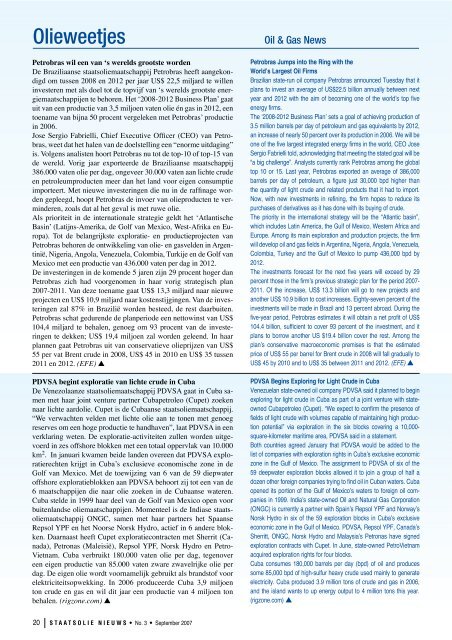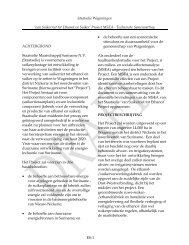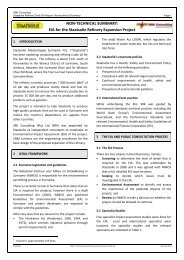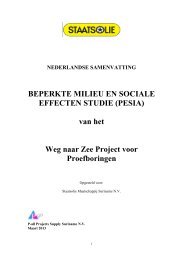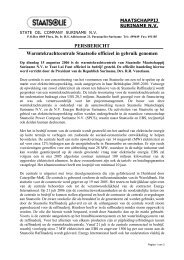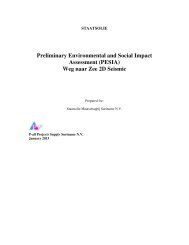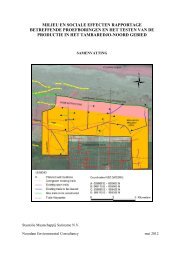staatsolie nieuws
staatsolie nieuws
staatsolie nieuws
Create successful ePaper yourself
Turn your PDF publications into a flip-book with our unique Google optimized e-Paper software.
Olieweetjes Oil & Gas News<br />
Petrobras wil een van ‘s werelds grootste worden<br />
De Braziliaanse <strong>staatsolie</strong>maatschappij Petrobras heeft aangekondigd<br />
om tussen 2008 en 2012 per jaar US$ 22,5 miljard te willen<br />
investeren met als doel tot de topvijf van ‘s werelds grootste energiemaatschappijen<br />
te behoren. Het ‘2008-2012 Business Plan’ gaat<br />
uit van een productie van 3,5 miljoen vaten olie én gas in 2012, een<br />
toename van bijna 50 procent vergeleken met Petrobras’ productie<br />
in 2006.<br />
bras,<br />
weet dat het halen van de doelstelling een “enorme uitdaging”<br />
is. Volgens analisten hoort Petrobras nu tot de top-10 of top-15 van<br />
de wereld. Vorig jaar exporteerde de Braziliaanse maatschappij<br />
386.000 vaten olie per dag, ongeveer 30.000 vaten aan lichte crude<br />
en petroleumproducten meer dan het land voor eigen consumptie<br />
den<br />
gepleegd, hoopt Petrobras de invoer van olieproducten te verminderen,<br />
zoals dat al het geval is met ruwe olie.<br />
Als prioriteit in de internationale strategie geldt het ‘Atlantische<br />
Basin’ (Latijns-Amerika, de Golf van Mexico, West-Afrika en Europa).<br />
Tot de belangrijkste exploratie- en productieprojecten van<br />
Petrobras behoren de ontwikkeling van olie- en gasvelden in Argentinië,<br />
Nigeria, Angola, Venezuela, Colombia, Turkije en de Golf van<br />
Mexico met een productie van 436.000 vaten per dag in 2012.<br />
De investeringen in de komende 5 jaren zijn 29 procent hoger dan<br />
Petrobras zich had voorgenomen in haar vorig strategisch plan<br />
2007-2011. Van deze toename gaat US$ 13,3 miljard naar nieuwe<br />
projecten en US$ 10,9 miljard naar kostenstijgingen. Van de investeringen<br />
zal 87% in Brazilië worden besteed, de rest daarbuiten.<br />
Petrobras schat gedurende de planperiode een nettowinst van US$<br />
104,4 miljard te behalen, genoeg om 93 procent van de investeringen<br />
te dekken; US$ 19,4 miljoen zal worden geleend. In haar<br />
plannen gaat Petrobras uit van conservatieve olieprijzen van US$<br />
55 per vat Brent crude in 2008, US$ 45 in 2010 en US$ 35 tussen<br />
2011 en 2012. (EFE) <br />
PDVSA begint exploratie van lichte crude in Cuba<br />
De Venezolaanze <strong>staatsolie</strong>maatschappij PDVSA gaat in Cuba samen<br />
met haar joint venture partner Cubapetroleo (Cupet) zoeken<br />
naar lichte aardolie. Cupet is de Cubaanse <strong>staatsolie</strong>maatschappij.<br />
“We verwachten velden met lichte olie aan te tonen met genoeg<br />
reserves om een hoge productie te handhaven”, laat PDVSA in een<br />
verklaring weten. De exploratie-activiteiten zullen worden uitgevoerd<br />
in zes offshore blokken met een totaal oppervlak van 10.000<br />
km 2 . In januari kwamen beide landen overeen dat PDVSA exploratierechten<br />
krijgt in Cuba’s exclusieve economische zone in de<br />
Golf van Mexico. Met de toewijzing van 6 van de 59 diepwater<br />
offshore exploratieblokken aan PDVSA behoort zij tot een van de<br />
6 maatschappijen die naar olie zoeken in de Cubaanse wateren.<br />
Cuba stelde in 1999 haar deel van de Golf van Mexico open voor<br />
buitenlandse oliemaatschappijen. Momenteel is de Indiase <strong>staatsolie</strong>maatschappij<br />
ONGC, samen met haar partners het Spaanse<br />
Repsol YPF en het Noorse Norsk Hydro, actief in 6 andere blokken.<br />
Daarnaast heeft Cupet exploratiecontracten met Sherrit (Canada),<br />
Petronas (Maleisië), Repsol YPF, Norsk Hydro en Petro-<br />
Vietnam. Cuba verbruikt 180.000 vaten olie per dag, tegenover<br />
een eigen productie van 85.000 vaten zware zwavelrijke olie per<br />
dag. De eigen olie wordt voornamelijk gebruikt als brandstof voor<br />
elektriciteitsopwekking. In 2006 produceerde Cuba 3,9 miljoen<br />
ton crude en gas en wil dit jaar een productie van 4 miljoen ton<br />
behalen. (rigzone.com) <br />
20 STAATSOLIE NIEUWS • No. 3 • September 2007<br />
Petrobras Jumps into the Ring with the<br />
World’s Largest Oil Firms<br />
Brazilian state-run oil company Petrobras announced Tuesday that it<br />
plans to invest an average of US$22.5 billion annually between next<br />
year and 2012 with the aim of becoming one of the world’s top five<br />
energy firms.<br />
The ‘2008-2012 Business Plan’ sets a goal of achieving production of<br />
3.5 million barrels per day of petroleum and gas equivalents by 2012,<br />
an increase of nearly 50 percent over its production in 2006. We will be<br />
one of the five largest integrated energy firms in the world, CEO Jose<br />
Sergio Fabrielli told, acknowledging that meeting the stated goal will be<br />
“a big challenge”. Analysts currently rank Petrobras among the global<br />
top 10 or 15. Last year, Petrobras exported an average of 386,000<br />
barrels per day of petroleum, a figure just 30,000 bpd higher than<br />
the quantity of light crude and related products that it had to import.<br />
Now, with new investments in refining, the firm hopes to reduce its<br />
purchases of derivatives as it has done with its buying of crude.<br />
The priority in the international strategy will be the “Atlantic basin”,<br />
which includes Latin America, the Gulf of Mexico, Western Africa and<br />
Europe. Among its main exploration and production projects, the firm<br />
will develop oil and gas fields in Argentina, Nigeria, Angola, Venezuela,<br />
Colombia, Turkey and the Gulf of Mexico to pump 436,000 bpd by<br />
2012.<br />
The investments forecast for the next five years will exceed by 29<br />
percent those in the firm’s previous strategic plan for the period 2007-<br />
2011. Of the increase, US$ 13.3 billion will go to new projects and<br />
another US$ 10.9 billion to cost increases. Eighty-seven percent of the<br />
investments will be made in Brazil and 13 percent abroad. During the<br />
five-year period, Petrobras estimates it will obtain a net profit of US$<br />
104.4 billion, sufficient to cover 93 percent of the investment, and it<br />
plans to borrow another US $19.4 billion cover the rest. Among the<br />
plan’s conservative macroeconomic premises is that the estimated<br />
price of US$ 55 per barrel for Brent crude in 2008 will fall gradually to<br />
US$ 45 by 2010 and to US$ 35 between 2011 and 2012. (EFE) <br />
PDVSA Begins Exploring for Light Crude in Cuba<br />
Venezuelan state-owned oil company PDVSA said it planned to begin<br />
exploring for light crude in Cuba as part of a joint venture with stateowned<br />
Cubapetroleo (Cupet). “We expect to confirm the presence of<br />
fields of light crude with volumes capable of maintaining high production<br />
potential” via exploration in the six blocks covering a 10,000square-kilometer<br />
maritime area, PDVSA said in a statement.<br />
Both countries agreed January that PDVSA would be added to the<br />
list of companies with exploration rights in Cuba’s exclusive economic<br />
zone in the Gulf of Mexico. The assignment to PDVSA of six of the<br />
59 deepwater exploration blocks allowed it to join a group of half a<br />
dozen other foreign companies trying to find oil in Cuban waters. Cuba<br />
opened its portion of the Gulf of Mexico’s waters to foreign oil companies<br />
in 1999. India’s state-owned Oil and Natural Gas Corporation<br />
(ONGC) is currently a partner with Spain’s Repsol YPF and Norway’s<br />
Norsk Hydro in six of the 59 exploration blocks in Cuba’s exclusive<br />
economic zone in the Gulf of Mexico. PDVSA, Repsol YPF, Canada’s<br />
Sherritt, ONGC, Norsk Hydro and Malaysia’s Petronas have signed<br />
exploration contracts with Cupet. In June, state-owned PetroVietnam<br />
acquired exploration rights for four blocks.<br />
Cuba consumes 180,000 barrels per day (bpd) of oil and produces<br />
some 85,000 bpd of high-sulfur heavy crude used mainly to generate<br />
electricity. Cuba produced 3.9 million tons of crude and gas in 2006,<br />
and the island wants to up energy output to 4 million tons this year.<br />
(rigzone.com)


